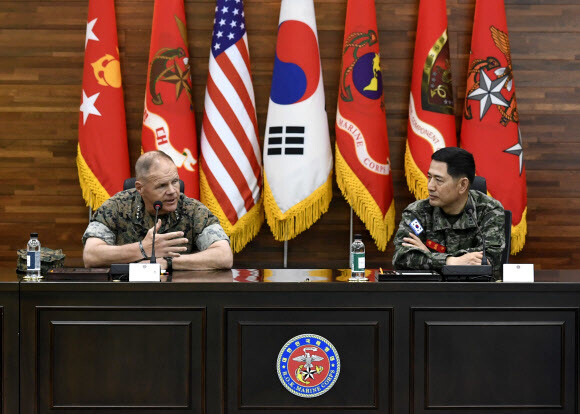hankyoreh
Links to other country sites 다른 나라 사이트 링크
Pacific commander of US Marines says it deployed 14 aircraft to S. Korea for joint exercises

Lieutenant General Lewis Craparotta, commander of US Marine Corps Forces Pacific, disclosed that 14 US aircraft had been deployed from Hawaii to South Korea for exercises last month with the South Korean marines, or the ROK Marine Corps. Craparotta made this announcement in a document titled “Role of the Marines in Strengthening the ROK-US Alliance” that was released on Apr. 1, prior to an international symposium on the 70th anniversary of the establishment of the ROK Marine Corps, which is part of a national defense convention being held in Seoul’s Yongsan District on Apr. 2.
Craparotta said that US marines’ “readiness improves every time they come to train” with the South Korean marines and navy. According to the lieutenant general, four MV-22 Ospreys, four CH-53 helicopters, four new Cobra helicopters and two new UH-1H Huey helicopters were deployed from Hawaii to South Korea last month.
“For the Hawaii marines, this was a great opportunity to train with Korean marines and special operations forces,” Craparotta said, stressing that training with the South Korean troops had improved the US marines’ combat readiness.
Craparotta was referring to the ROK-US Korea Marine Exercise Program (KMEP), large-scale drills that were delayed after the North Korea-US summit in Singapore on June 12, 2018, and then resumed the following November. Though this program was supposed to consist of 19 rounds last year, only 11 of those actually took place. This year, all 24 rounds of the program are scheduled to proceed.
According to Craparotta, KMEP includes a variety of training tasks that provide South Korean and US marines with a valuable opportunity to master challenging aspects of actual amphibious operations.
The US Pacific marine commander also observed that the ROKS Dokdo and the ROKS Marado, large amphibious attack vessels in the South Korean navy categorized as “landing platform helicopters,” (LPH) had been designed to carry the Marineon helicopters and suggested that US F-35B stealth fighters could also land on these ships during future training operations. If the ROK and US Marines continue to develop their ability to train and operate together, Craparotta said, there’s no reason why US Marine Corps F-35B fighters couldn’t land on those ships in the future.
Craparotta said that the US was encouraging South Korea to keep participating in upcoming amphibious exercises in the Philippines and that the US Marines wanted South Korea to be its partner in the Philippines to ensure the success of those multinational exercises. He also said that South Korean landing forces were always welcome to participate in the RIMPAC (Rim of the Pacific) exercises, which are organized on odd-numbered years by the US Pacific Fleet, and that the US Marine invited the ROK Marines to participate in Exercise Talisman Saber, a joint exercise between the US and Australia that’s held on even-numbered years.
In order to overcome the difficulties of gaining permission to train with foreign armies in other countries, Craparotta added, the US was working to set up training grounds on Guam and in the Northern Mariana Islands and that the US Marine looks forward to training with the ROK Marine in those locations.
By Yoo Kang-moon, senior staff writer
Please direct comments or questions to [english@hani.co.kr]

Editorial・opinion
![[Column] Season 2 of special prosecutor probe may be coming to Korea soon [Column] Season 2 of special prosecutor probe may be coming to Korea soon](https://flexible.img.hani.co.kr/flexible/normal/500/300/imgdb/original/2024/0426/3317141030699447.jpg) [Column] Season 2 of special prosecutor probe may be coming to Korea soon
[Column] Season 2 of special prosecutor probe may be coming to Korea soon![[Column] Park Geun-hye déjà vu in Yoon Suk-yeol [Column] Park Geun-hye déjà vu in Yoon Suk-yeol](https://flexible.img.hani.co.kr/flexible/normal/500/300/imgdb/original/2024/0424/651713945113788.jpg) [Column] Park Geun-hye déjà vu in Yoon Suk-yeol
[Column] Park Geun-hye déjà vu in Yoon Suk-yeol- [Editorial] New weight of N. Korea’s nuclear threats makes dialogue all the more urgent
- [Guest essay] The real reason Korea’s new right wants to dub Rhee a founding father
- [Column] ‘Choson’: Is it time we start referring to N. Korea in its own terms?
- [Editorial] Japan’s rewriting of history with Korea has gone too far
- [Column] The president’s questionable capacity for dialogue
- [Column] Are chaebol firms just pizza pies for families to divvy up as they please?
- [Column] Has Korea, too, crossed the Rubicon on China?
- [Correspondent’s column] In Japan’s alliance with US, echoes of its past alliances with UK
Most viewed articles
- 1Samsung subcontractor worker commits suicide from work stress
- 2Division commander ordered troops to enter raging flood waters before Marine died, survivor says
- 3No good, very bad game for Korea puts it out of Olympics for first time since 1988
- 4‘We must say no’: Seoul defense chief on Korean, USFK involvement in hypothetical Taiwan crisis
- 5[Column] Season 2 of special prosecutor probe may be coming to Korea soon
- 6Is N. Korea threatening to test nukes in response to possible new US-led sanctions body?
- 7Korea’s 1.3% growth in Q1 signals ‘textbook’ return to growth, says government
- 8US overtakes China as Korea’s top export market, prompting trade sanction jitters
- 9[Column] Has Korea, too, crossed the Rubicon on China?
- 10[Column] ‘Choson’: Is it time we start referring to N. Korea in its own terms?